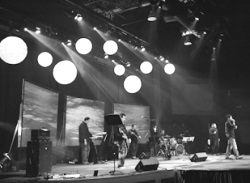
Second, I bought good equipment. The Aviom system rocks. It’s that simple. I also went with good ear buds, Westone UM1s for the guitars and keys and AKG K240 headphones for drums and bass.
I couldn’t afford ear buds that went deep enough (the UM2s would have been nice), so I bought good headphones. Honestly, they look fine on stage, and some have commented they look really cool.
Third, I rolled it out in stages. I started with the drums and bass first, and they fell in love. It didn’t take long for the guitars and keys to want their own “ears.”
I have had almost a 100 percent acceptance rate, and the only people who weren’t crazy about them at first were those not on ears. Not because they wanted them, but because they missed the “feel” of the sound.
Once we dropped the stage level from the mid to high 90 dB range, to the mid 70s, they didn’t feel the sound as much. It was mainly a problem during rehearsal when the house system wasn’t on. It took me a few months to solve the problem (it should have taken a week, what can I say…).
Now we simply turn the house system on for rehearsal – everyone’s happy.
The system is not perfect; none is I guess. At first 16 channels seemed like a whole lot, but when we started breaking it down, we ran out pretty fast.
The problem is I have musicians who sing, and they need to hear their vocals and their instrument, so that really adds up. I thought I could get by with using group outs, but that doesn’t allow enough control. More aux sends would be helpful after all.
Because we have four different worship teams, each with a different musical makeup, I end up re-patching the direct outs each week to accommodate everyone. At first I tried to avoid this, but in the end it makes life easier.
The overall effect of the system is fantastic despite these minor limitations. The house sound has improved so dramatically I actually have people commenting on it (how often does that happen?).
Our engineer’s workload is greatly reduced, so they can spend more time finessing the mix, and less time trying to make the monitors work. We can run a much lower house volume, with cleaner sound that still feels great.
And the musicians really love it. Some have taken to bringing their own headsets, which is fine, and those who are not yet on “ears” are asking when I’m getting them a set.
The cost was very reasonable, and the beauty of the system is its expandability. We started off with an input module and four stations for under $2,500. We can add stations for less than $500, and we can add as many as we want.
Next budget year I will be buying a powered hub to sit on stage that will power the mixers over the Cat-5, eliminating the wall warts. If you are facing the problem described at the beginning of this article, I highly recommend this system.
Not only have we enjoyed a cease-fire agreement, but we are now in nearly complete peace. Worship leading has become fun again!
Mike Sessler is the Technical Director at Coast Hills Community Church in Aliso Viejo, CA. He has been involved in live production for over 20 years and is the author of the blog, Church Tech Arts . He also hosts a weekly podcast called Church Tech Weekly on the TechArtsNetwork.
